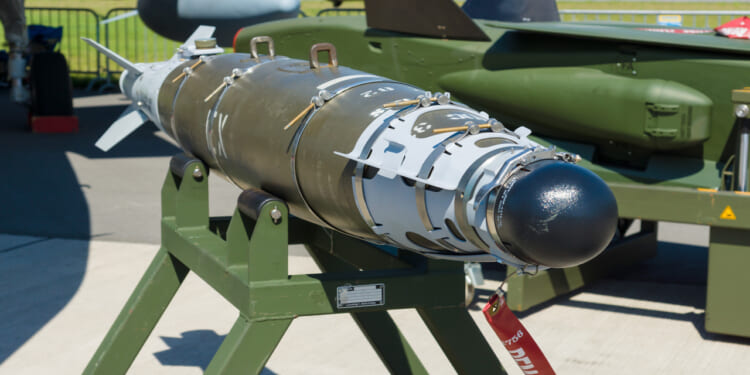JDAM is a guidance kit that can turn “dumb” bombs into “smart” bombs.
The Russian military is working on a rocket-propelled bomb that could glide up to 120 miles and hit Ukrainian targets.
According to the Ukrainian military intelligence, the Russian Aerospace Forces are developing a glide bomb propelled by rockets in an effort to bolster their long-range fires arsenal.
Glide Bombs Propelled By Rockets
According to Vadym Skibitskyi, deputy chief of Ukraine’s Defense Intelligence Directorate (HUR), the Russian Aerospace Forces have developed and deployed an “experimental long-range aerial munitions” that can strike targets approximately 90 to 120 miles away.
The Russian Aerospace Forces reportedly have been testing several different munitions, including Grom-E1, UMPB-5R, and UMPK munitions. Specifically, the Russian military has been trying to pair a guidance kit with these munitions in order to increase their capabilities and range.
The Russian Aerospace Forces are likely trying to replicate the US military’s Joint Direct Attack Munition (JDAM). JDAM packages turn “dumb” bombs into “smart” bombs. JDAM is a guidance kit that can be paired with a wide range of conventional bombs, including 2,000-lb., 1,000-lb., and 500-lb. munitions, to create a guided, all-weather bomb that can hit targets with pinpoint accuracy. JDAM technology is pretty clever and has allowed the US military to use its vast store of bombs effectively in modern conflicts. JDAM technology is also cost-effective, as the guidance packages cost significantly less than a completely new munition. Each JDAM package costs, on average, approximately $21,000.
The reported range of the Russian glide bombs suggests an intent for tactical use. A range of up to 120 miles would not be of much use against major Ukrainian urban centers, such as Kyiv and Odessa, or against critical infrastructure targets. But such a range would be ideal for tactical strikes against frontline and logistics targets. Fighter jets, attack jets, and bombers are essentially absent from close air support missions on the frontlines.
If effective, the new glide bomb would also offer an additional strike option for Russian fighter jets and bombers.
The Air War Over Ukraine
The airspace over Ukraine remains contested, with neither side having established air superiority. Although that is not a surprise on the part of the Ukrainian Air Force, it is quite a surprise on the part of the Russian Aerospace Forces. Russia has significantly more advanced aircraft than Ukraine. But Russian fighter jets and bombers failed to suppress the Ukrainian air defenses in the opening stages of the conflict. Later on, Ukraine’s partners transferred powerful air defense systems to the Ukrainian military. Indeed, the Ukrainian Air Force currently operates MIM-104 Patriot, IRIS-T, and National Advanced Surface-to-Air Missile System (NASAMS) air defense weapons. Ukraine’s robust air defense capabilities now make it impossible for Russian aircraft to establish air superiority and control the skies over Ukraine.
The development of rocket-propelled glide bombs is an innovative way to bypass the limitations imposed by the Ukrainian air defenses. However, the Ukrainians can likely still intercept glide bombs if they choose to, albeit at a high cost.
About the Author: Stavros Atlamazoglou
Stavros Atlamazoglou is a seasoned defense journalist specializing in special operations and a Hellenic Army veteran (national service with the 575th Marine Battalion and Army HQ). He holds a BA from the Johns Hopkins University and an MA from the Johns Hopkins’ School of Advanced International Studies (SAIS). His work has been featured in Business Insider, Sandboxx, and SOFREP.
Image: Sergey Kohl / Shutterstock.com


















